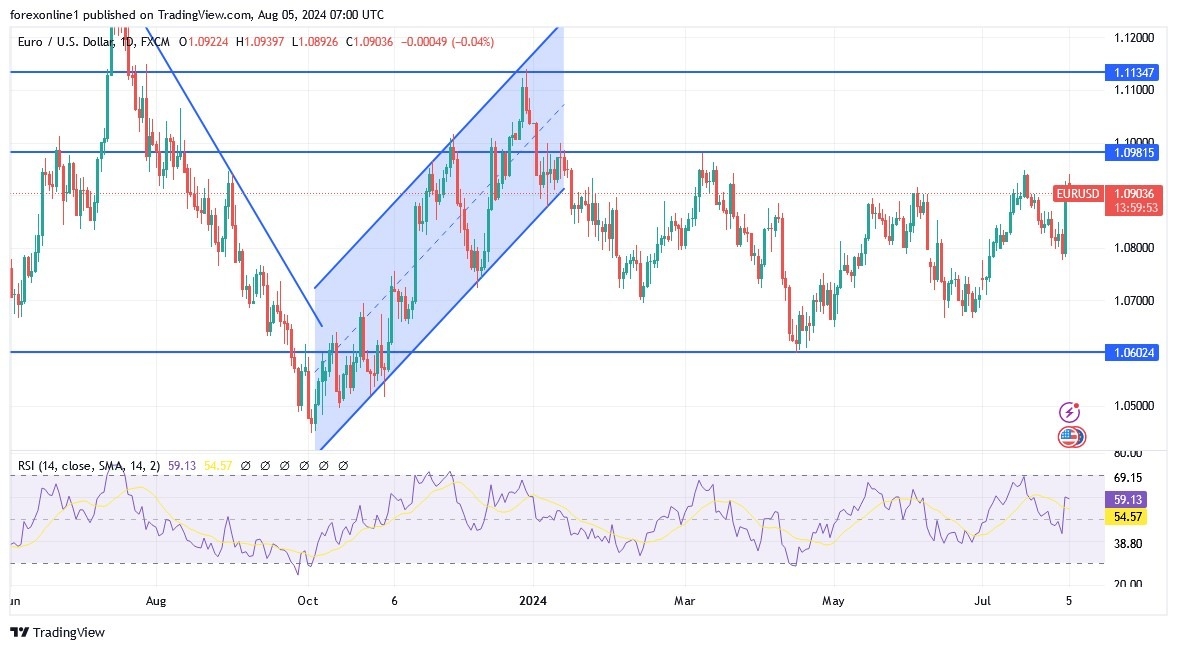- At the end of last week’s trading, the euro rose by about 1%, surpassing the resistance level of 1.0926 before closing the week’s trading stable around the level of 1.0910.
- Its surprising gains came, benefiting from the weakness of the US dollar in general, amid concerns about the strength of the US economy in the wake of the disappointing jobs report.
- This had led to speculation that the Federal Reserve may need to cut US interest rates three times this year instead of twice.
Meanwhile, traders continue to price in at least two interest rate cuts by the European Central Bank this year, with the next cut likely in September. So far, ECB official Stournaras had highlighted the possibility of inflation falling below the 2% target due to the struggling eurozone economy.
In terms of economic data, the annual rate of inflation in the Eurozone unexpectedly accelerated to 2.6% in July, but service inflation declined for the first time in three months. Preliminary estimates showed that the Eurozone economy expanded faster than expected by 0.3% in the second quarter, driven by growth in France, Italy, and Spain. On the other hand, the German economy contracted unexpectedly.
Overall, slightly higher-than-expected inflation data has maintained concerns about the risk of persistent inflation, despite continued market expectations of interest rate cuts by the ECB again in September. HSBC economist Fabio Balboni commented: "It's a tricky print for the ECB, as commodity deflation is nearing its end and service inflation remains elevated."
Inflation in the services sector fell to 4.0% from 4.1%, and ABN Amro was slightly more positive; “This kind of decline bodes well for the medium-term inflation outlook.”
On the stock exchanges front, European stocks extend losses. According to electronic trading, both the Stoxx 50 and Stoxx 600 indexes extended their declines and closed down 2.8% on Friday after the US jobs report came in weaker than expected, adding to concerns about a slowdown in the US economy. Earlier, an unexpectedly large contraction in the US manufacturing sector and a series of mixed earnings results from Apple and Amazon were already weighing on investor sentiment.
On the institutional front, shares in the euro zone’s largest company by market value, ASML, fell 11.2%, tracking a sell-off in the global chip sector. also, Siemens (-4%) and Schneider Electric (-4.8%) fell sharply. The financial services sector was also down, with Santander losing 5.5% while UniCredit, Instesa Sanpaolo and BNP Paribas lost between 5% and 3%.
Over the week, the STOXX 50 index fell 3.7% and the STOXX 600 index fell 2.8%.
Top Forex Brokers
EUR/USD Technical analysis and forecast:
The recent EUR/USD bounce lacks the momentum to confirm a bullish trend, which will happen if it settles above the psychological resistance of 1.1000. concurrently, we expect a quiet trading week in narrow ranges after the recent central bank announcements and economic data results. Also, we still prefer to sell the EUR/USD from every bullish level. Based on the performance on the daily chart, the support level of 1.08 will remain a threat to any attempt to bounce higher.
Ready to trade our Forex daily forecast? We’ve shortlisted the best forex broker list for you to check out


